
Abstract
Before we begin delving into the subject matter of “dark faeries,” a discussion of the aims of the Pre-Raphaelite Brotherhood may be helpful. Although today many people tend to group any European Romantic painters under the term “Pre-Raphaelite,” that term does not extend to all Romantic painters. The Pre-Raphaelite Brotherhood was founded by Dante Gabriel Rossetti in 1848, along with William Holman Hunt, John Everett Millais, William Michael Rossetti, James Collinson, Frederic George Stephens, and Thomas Woolner. This group of seven included painters, poets, sculptors, and art critics. In time, their circle included more artists, designers, writers, and critics including William Morris, Ford Maddox Brown, Marie Spartali Stillman, and Christina Rossetti. They were mirroring another group of artists known as the Nazarenes, so called because of the biblical dress and subject matter of their works. Their principles arose as a direct reaction to the Industrial Age. They stressed an emphasis on creating works based on the direct observation of nature and to “to sympathise with what is direct and serious and heartfelt in previous art, to the exclusion of what is conventional and self-parading and learned by rote” (Latham, para 10 – 11, 2017).
One of the inspirations seen as heartfelt and serious for the Pre-Raphaelites was folklore. Many of their works were biblically themed, as they often felt there needed to be a strong moral direction in art, however they also enjoyed looking at tales from folklore, myth, Arthurian literature, and Romantic poetry, among other things, for these purposes. This was the Victorian era, and faeries were extremely popular in illustration and literature. While they seem as though they might in direct opposition with Pre-Raphaelite themes, as faeries were not considered by many to be observational in nature, it was the moral content often seen in stories involving faeries that interested the Pre-Raphaelites and made those stories crucial narrative devices in Pre-Raphaelite symbolism and imagery.
The Fae themselves were considered, in Celtic mythology, to be divided into two camps: The Seelie and UnSeelie Courts. The Seelie were considered to be the “good” faeries, and the Unseelie the “bad’ faeries, although anyone who has done any serious reading knows that either Court could be quite fickle when it came to their relationships with human beings. The terms Fae, Fairy, and Faery are used in a number of cultures to refer to non-humans who may or may not be visible to the human eye, and who may cause both help and harm to their human neighbors. The Realm of the Fae was considered to be a place of both beauty and terror and, as such, was of great interest to the Pre-Raphaelite painters.
It is also worth noting that during this time, the Industrial Age was creating a literary and visual language of its own around humanity and the forces of nature. There were many artists interested in capturing one or two sides of this coin. On one side was the struggle of humanity against the sublime terror of nature. Works like Theodore Gericault’s Raft of the Medusa depicts the aftermath of the wreck of French frigate known as The Medusa, and it is indeed horrifying: human bodies writhing on a raft drifting at sea, having endured starvation and thirst, and resorting to cannibalism. On the other side are depictions of the sublime beauty of nature. Works by J. M. W. Turner and Constable elevated and illuminated the natural world. With these dichotomies firmly in place, it is no surprise that the Pre-Raphaelites explored the stories and imagery of the Dark Fae.
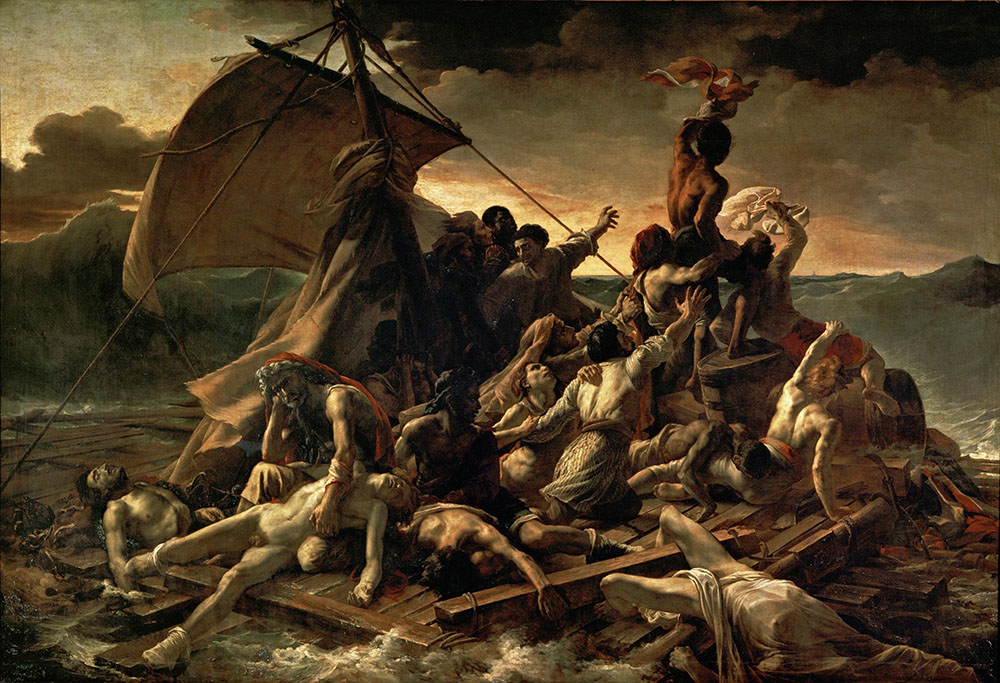
Folklore of the unseen world has always included beings of both benevolent and malevolent natures. The aforementioned “Courts” in Celtic folklore are an example of this. The Unseelie Court were also known as the Slaugh, meaning “host,” and were supposedly cast out of the Seelie Court for various offenses. They were said to appear as a dark cloud being carried by the wind at night, and they were often blamed for natural disasters in the moral world. Characters that might appear first as old hags, and then transform themselves into beautiful maidens, were not unheard of, as well as cruel, glamourous women who would enchant mortal men to their deaths. The Leanan-Sidhe, in particular, would inspire young men to write beautiful poetry, literature, or music, and then discard them once their purpose had been served.
In Germanic folklore, there are tales of creatures like the Dokkalfar or “dark elves” in Norse mythology. These beings were often associated with the underworld and were believed to be more malevolent and unpredictable than the Ljosalfar or “light elves.” Other beings, such as Lake Wives, could be both good and bad, in that they protected the bodies of water in which they dwelt, but could also spell disaster for fishermen who captured fish from the Lake Wife’s own herd.
Clearly, the folklore and stories told about dark faeries from many different cultures play out the notion of the Victorian Age’s concerns regarding humans and the ambiguity and duality of nature. Additionally, during the late nineteenth and early twentieth centuries, the resurgence of interest in the supernatural, the occult, and the metaphysical present opportunities for luscious narrative imagery. The Pre-Raphaelites would have been especially drawn to stories of seduction, temptation, and danger.
It is impossible to include all of the great references in Pre-Raphaelite art to dark faeries, however there are some notable examples to be highlighted. Sir John Everett Millais, was inspired by a poem written by Tennyson, which in turn was inspired by the character Mariana in Shakespeare’s Measure for Measure. Mariana stands by the window, her back aching from all the tedious embroidery she has been doing. Ditched by her fiancé for having lost her dowry in a shipwreck, she is still in love and wishing for death. She is much like John William Waterhouse’s Lady of Shalott.
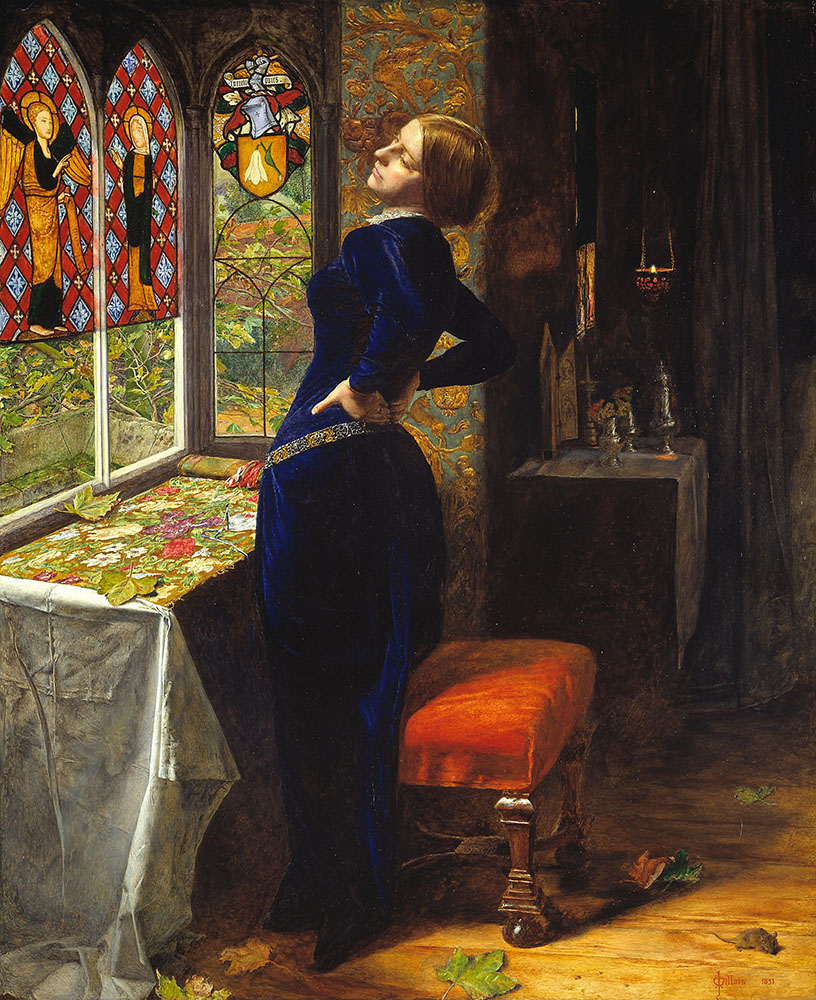
In another poem by Lord Tennyson, we learn of the plight of the doomed titular character, the Lady of Shalott. This unfortunate woman is under a curse which keeps her forever weaving a tapestry, and if she dares to leave her island prison to go forth to Camelot (which she can only view from a mirror in her room), the curse will be loosed upon her. “No other care hath she” beyond her tapestry, says the poem, until one day she catches sight of the handsome Lancelot. She sighs and says, “I’m half-sick of shadows,” and departs for Camelot, whatever doom may befall her. She dies, beautifully dressed, in the boat she attempts to take to Camelot. “A pearl garland winds her head:/She leaneth on a velvet bed/ Full royally appareled/ The Lady of Shalott.” Her little boat continues to Camelot, where she is found by the confounded members of the Court, who don’t understand why a beautiful, dead fairy would be appearing on their shoreline.

These unhappy or doomed women reflect upon the attitudes of the Pre-Raphaelites themselves, and the times in which they lived. John Everett Millais painted fellow painter Elizabeth Siddal, who was eventually married to Dante Gabriel Rossetti, as Hamlet’s doomed Ophelia. When Elizabeth Siddal died from drinking too much laudanum after the loss of a child, Rossetti idealized her as Dante’s Beatrice. The men of the Pre-Raphaelite brotherhood seemed obsessed with the notion of acting as saviors to lower-class women, “saving” them either from lowered morals or financial circumstances and raising their status through marriage or other means. Elizabeth Siddal certainly suffered due to this attitude. She posed for Millais in a bathtub for five months, nearly dying from the ensuing illness (for which her father sued Millais). She and Rossetti had an intense affair and married. Although she, like Rossetti, was both a poet and painter, her life and career were eclipsed by that of her husband.
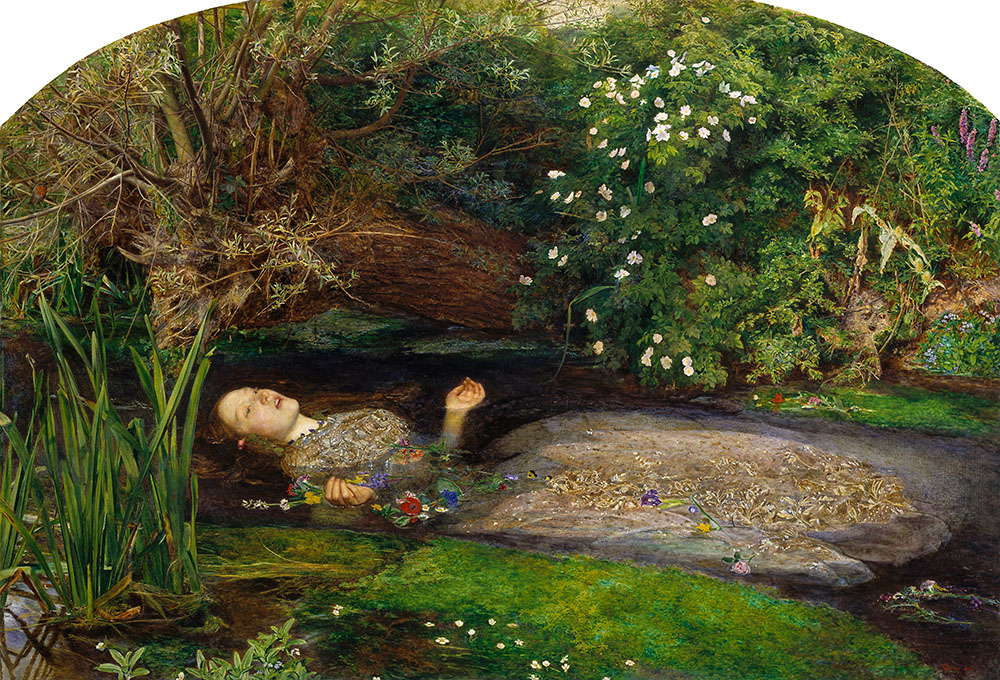
Edward Burne-Jones is remarkable as a Pre-Raphaelite because he wasn’t interested in the rich, brilliant hues used by other painters in the brotherhood, but preferred to explore the dark and mysterious, which was reflected in his palette of blues, grays, and greens. He also did not fear controversy. In 1870, he caused a scandal with his painting Phyllis and Demophoӧn, which depicted full frontal male nudity. The dark faery painting that he is perhaps best known for is The Beguiling of Merlin, in which a young and beautiful Nimue traps Merlin by using a spell from his own grimoire, which she holds aloft in the painting. His Nimue is tall like the trees under which she stands, and her long neck cranes over her shoulder to ensure the spell is taking effect. Merlin is ensnared in vines, looking helpless to alter his fate. Unlike Mariana and Waterhouse’s The Lady of Shallot, Nimue represents a very unsympathetic view of female sexuality, and it is definitely not the only time this view is seen amongst the Pre-Raphaelites.
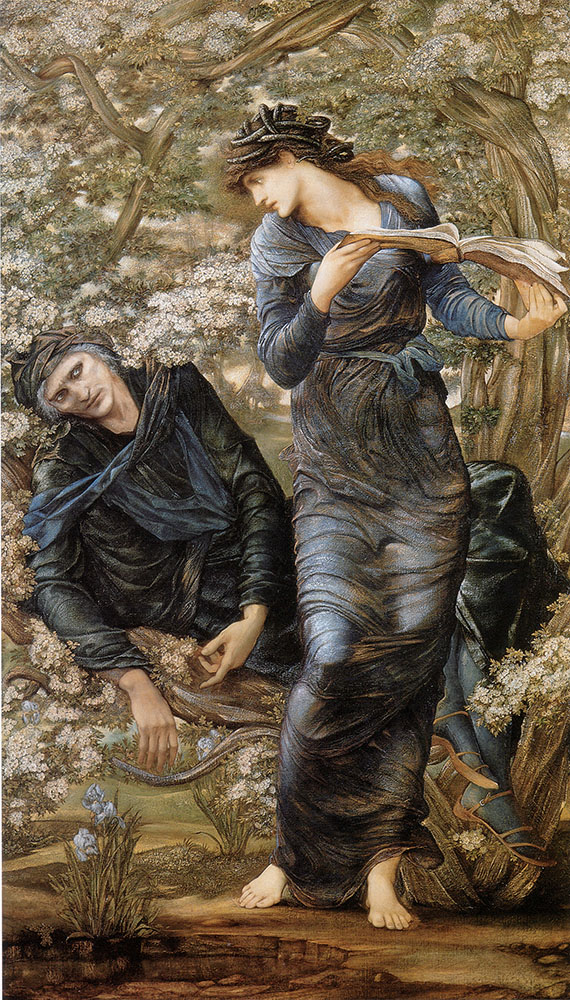
John William Waterhouse embodied another Pre-Raphaelite sexist attitude in his painting La Belle Dame Sans Merci, another painting based on a poem by Lord Tennyson. (Lord Tennyson was rather considered an honorary member of the brotherhood). Waterhouse’s version of the painting shows a beautiful and alluring woman seductively pulling a knight in armor towards herself by wrapping her long silken hair around his throat. The lady is barefoot and appears to pose no immediate threat, yet in Tennyson’s poem we know the knight is helplessly lovestruck and unable to escape the peril before him. Victorian men seem to have had great fears of women using their beauty to ensnare them into marriage, which hardly seems fair as women had very few choices in that era but to marry, and hopefully marry someone richer than themselves. This Victorian attitude towards women is one that sadly persists to this day, in which men are ensnared by the soft, seductive beauty of evil temptresses without concern for what their female subjects’ lives might actually be like.
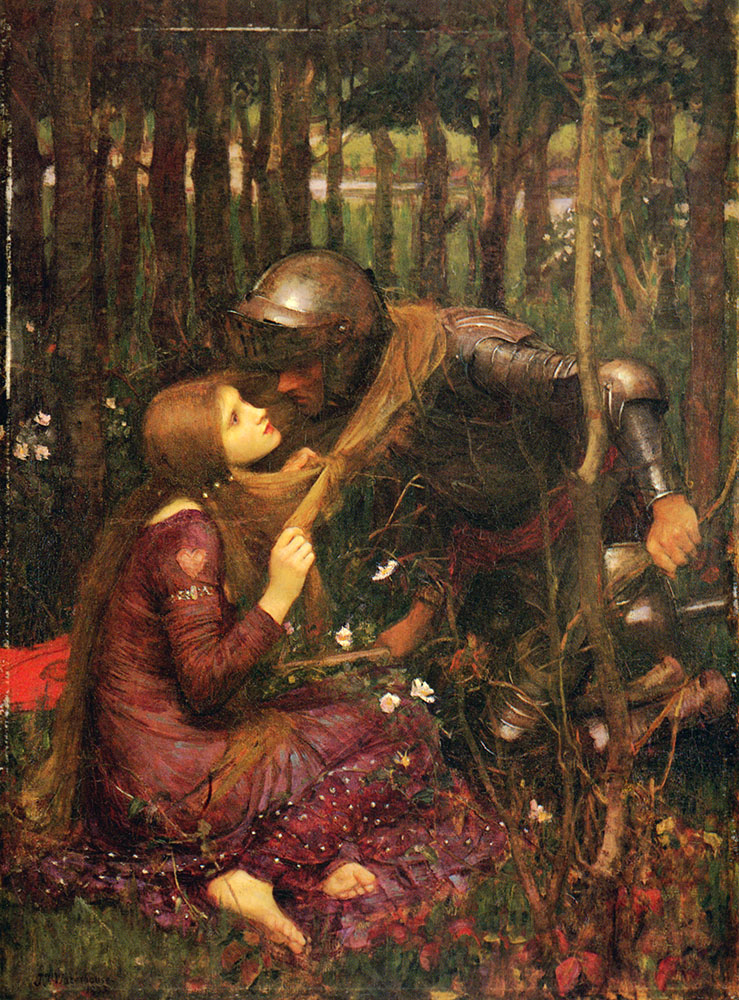
As with all art and artists, the works of the Pre-Raphaelites reflects, for better or worse, on the prevailing ideas of the time. At this moment in history, female sexuality was considered a thing of mystery and danger, so it is not surprising at all that alluring, beautiful faery women would become visual stand-ins for their human female counterparts. These paintings still have appeal to this day, turning up as posters in many a college dorm room, and amongst lovers of all things Fae. Although they may represent the attitudes and ethos of a time best left in the past, we can still enjoy them for the beauty and richness they bring to our eyes.
References
 Helena Domenic is an accomplished artist, writer, witch, and professor of art history and studio art. Helena maintains a studio in Phoenixville, PA where she offers classes, workshops, and readings. Helena currently teaches drawing and painting at Kutztown University. Helena spent thirty years as a member of the Assembly of the Sacred Wheel and was also an Elder in that tradition. She left to carve out her own path, both as an artist and a witch. Currently, she offers classes in Tarot and Wicca and rituals in and around the Chester County area, and you might find her giving a book signing as well.
Helena Domenic is an accomplished artist, writer, witch, and professor of art history and studio art. Helena maintains a studio in Phoenixville, PA where she offers classes, workshops, and readings. Helena currently teaches drawing and painting at Kutztown University. Helena spent thirty years as a member of the Assembly of the Sacred Wheel and was also an Elder in that tradition. She left to carve out her own path, both as an artist and a witch. Currently, she offers classes in Tarot and Wicca and rituals in and around the Chester County area, and you might find her giving a book signing as well.
Helena has shown her artwork in Philadelphia, New York, across the United States and in Egypt and South Africa. Helena was born in Vicenza, Italy where she was exposed to great works of art from a very early age. After viewing the Sistine Chapel ceiling at the age of eighteen months, her mother predicted she would become an artist. She holds a BFA from Kutztown University, an MA in Art Education from The University of the Arts, and an MFA from Goddard College in Plainfield, Vermont.
Helena has written and published An Illuminated Guide to Wicca, available from Schiffer Publishing. Helena has also self published a Tarot deck and book, The Fellowship of the Fool Tarot.
In her spare time, she enjoys studying Tarot and Qabala, spending time in her studio, and hanging out with her husband Sean and their cats.
Helena’s work may also be seen on her website: http://www.artofhelenadomenic.com
Or visit her Facebook Pages:
https://www.facebook.com/helenadomenicart
https://www.facebook.com/TheArtisticMysticRocks
For more information, you may email Helena at helena@artofhelenadomenic.com